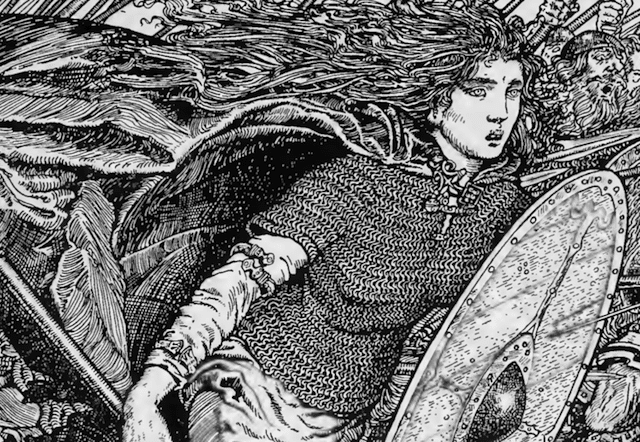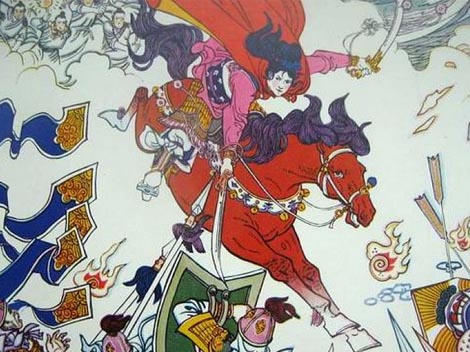In past TopTenz lists of badass women, we’ve often featured exclusively those that were in the military. While we don’t regret our choices and this list will feature many more, we’re going to widen the scope for this one. A person doesn’t need to be carrying a weapon to be a badass, though it sure does help.
From the more obscure eras of ancient history to modern history, from every civilization, we had a rich selection from which to choose. Best of all, many of these are people that you might not have heard a word about, so we’re happy to introduce you to them.
10. Inghen Ruaidh

In 10th Century Ireland, legend told of a time when there was practically a parade of invading fleets. According to the 19th Century record Cogadh Gaedhel Re Gallaibh, among the fleets were those led by such Danes and “pirates” as Milid Buu, Birndin, and “lastly” the fleet of Inghen Ruaidh. This last fleet was given special attention because Inghen Ruaidh translates to “Red-haired Maiden” in old Gaelic. Collectively they devastated the countryside.
For the longest time the account of the Maiden’s exploits at the head of a fleet of raiders was suspected of being a tall tale, just like all the 13th Century sagas that mention “shield maidens.” Then the credibility of her story got a major in 2017. It was reported by National Geographic that an examination of the body of a Viking warrior buried in Birka, Sweden roughly a millennium earlier that had been presumed to be male was actually female. Just as well: a raider tough enough to control her own fleet is probably someone you don’t want to dismiss out of hand, no matter how dead they are.
9. Gertrude Ederle

The first person who swam the English Channel did so in 1875, but the thought of achieving such a titanic swim in cold waters with a decent current had lost little of its luster by the time American Olympic gold medalist Gertrude Ederle stepped into the Channel in the summer of 1925. As it happened, the first time that she tried to swim the Channel, her manager thought she was swallowing too much water and made her quit after eight hours. So, she fired him and came back the next year. Her timing turned out to be extremely bad in practical terms, as the Channel was experiencing storms at the time. Nevertheless, after 14 hours she reached her objective and beat the previous record by two solid hours.
Although Ederle was celebrated at the time, complete with ticker tape parades attended by as many as two million people, and had a popular song written in tribute to her, she faded quickly from the public consciousness. By World War II she was working as an airport technician, and after that she became a swimming instructor. The instructor position gained a particular poignance as she had damaged her hearing in her record-setting swim and she taught at a school for the deaf. By 2013, Bill Bryson said she could have qualified as “the most forgotten person in America.”
8. Nieves Fernandez

Life should have been peaceful for Nieves Fernandez. Up to the age of 35, she had a respectable profession as a school teacher and entrepreneur on Leyte Island in the Philippines. A profile of her in the Lewiston Daily Sun described her as “prim.” She was steered away from that quiet life into one of fire and blood on December 8, 1941 when the Japanese Empire attacked the Philippines. As explained in other TopTenz lists, the Imperial Japanese Army was extremely cruel to many civilian populations, so it was only natural that Fernandez took action after being tortured with cold baths and hunger.
By the time the Allied army had liberated the Philippines in November 1944, Fernandez had assembled a force of 110 guerillas armed with shotguns made from pipes and loaded with nails. They killed an estimated 200 occupying soldiers, with Fernandez in particular demonstrating a knack for cutting throats. There was a 10,000 peso reward placed on her head, but understandably no takers.
7. Margarita Neri

In 1910, incumbent Mexican president Porfirio Díaz had his challenger Francisco Madero jailed and touched off a revolution that put Madero in power. Then there was another revolution against Madero to put in place a proper representative government. Among the ranks of those determined to overthrow Madero were an unusually large number of women. A report from Fort Bliss, Texas in 1914 claimed that a single group of roughly 5,000 revolutionaries included more than 1,000 women. Of the soldaderas, none inspired more fear than heiress and landowner turned guerilla soldier Margarita Neri. Perhaps surprisingly (or perhaps not), it was high taxes that sent her down the warpath.
Early on during the revolution, Neri was said to have been abandoned by her male compatriots. So she raised her own force of 200 men that would, in time, swell to 1,000 under the command of a General Figueroa. She was known for wielding a bloody machete and vowing to decapitate Diaz herself as she led raids on such targets as Tabasco and Chiapas, laying waste to enemy forces. A story emerged that the governor of the state of Guerrero had himself hidden in a crate to sneak out of her clutches. She was dubbed the “Joan of Arc” of Mexico by the Washington Herald. By all accounts, she did not survive to the end of the revolution, whether she went down fighting or was executed as a prisoner.
6. Pantea Arteshbod

As was explained in the TopTenz list on the subject of Amazon warriors, female warriors were a known feature of Ancient Eurasia. This extended down to the Persian Empire, which during its greatest period of expansion under Cyrus the Great allowed women to rise to the rank of general. Pantea Arteshbod and her General Ayrsab were a husband and wife team so successful for Persia that they were placed in charge of the elite Persian military unit, the Immortals. During peacetime this meant they were effectively Cyrus’s highest ranked military leaders.
Pantea’s greatest recorded known feat was when she performed a masterstroke that won the Persians the Battle of Opis in 539 BC. It was a momentous victory which led to the fall of Babylon under the Persian heel (an event that should be familiar to Christians as it sets the stage for much of what happens in the Book of Daniel). For her trouble, Pantea was made the governor of Babylon. Stories circulated that she wore a mask in battle because otherwise her immense beauty would cause men to immediately fall in love with her, which sounds suspiciously like General Ayrsab thought them up.
5. Juana Azurduy de Padilla

It turns out women in early 20th Century Central America had nothing on women in the 19th Century when it came to being willing to overthrow dictatorships. In 1802, a revolution began in Peru. One of the soldiers that took part was an orphaned former nun from what’s now Sucre, Bolivia who’d left her religious order to have four children with Manuel Padilla. Liberty would cost her the lives of her children, every penny she owned, and 23 years of her life.
As with Margarita Neri, Juana Padilla had something of a knack for raising, organizing, and then leading troops into battle. In 1810, Buenos Aires and the region that became Argentina joined the revolution against Spain, and Padilla and her husband began incursions into that territory. In 1816, Manuel was killed in combat. Passing into a mountainous region during a retreat, her four children died of disease and thirst, but she delivered a fifth one. That same year, her fellow commanders began to sufficiently acknowledge Padilla’s combat prowess that she was given an officer’s rank and a sword. There would be nine more years of war before the nation of Bolivia established an independent government. She would live to enjoy her freedom for 37 years in her hometown with her surviving daughter.
4. SB Patil
This will be the only entry on this list from current times, but it’s no less deserving of a place in history. On August 18, 2018, at 8:32 a.m. a fire was called in that engulfed much of the 12th floor of the Crystal Tower, a residential building in the upscale Dahar area of Mumbai, India. One of the responding firefighters was SB Patil, who was credited with saving 13 people that had been trapped by the fire. Two of the people she brought to safety were pregnant women, and two were children. This was no overblown fire: it resulted in more than 20 injuries and cost the lives of four people.
As it happened, Patil had some help in this mission from an unlikely source. Inside the building a 10-year-old girl named Zen Sadavarte reminded some of the stranded people on how to avoid suffocation in a fire. She contributed enormously to the survival of another 18 people beyond the 13 that Patil rescued in the three hours that it took to douse the fire. It was a tragedy that such heroism was needed at all, since as of October 2016 local civic groups and even the fire department were declaring the building unsafe.
3. Tang Sai’er

Thanks to the Walt Disney Company, the most famous female Chinese warrior is definitely Mulan. While Mulan supposedly saved the Chinese Empire from outsiders, this woman and her husband led a rebellion against the Ming Dynasty in the early 15th Century. After organizing a popular movement through the White Lotus Society, she led an attack on a group of Ming soldiers in Xieshipeng Village and defeated them so thoroughly that they killed their commander. The Ming government sent an army to put her rebellion down. She and her peasants defeated it. So, another Ming army was dispatched, and she destroyed this one so thoroughly that another Ming commander fell with his troops. Having indisputably seized the initiative, the peasant army went on the offensive, taking the cities of Ju and Jimu. Jimu would be her final victory, as the government sent a last army that crushed the uprising.
Sai’er then was able to pull off a trick most rebel leaders only wish they could: escape execution. While the government searched long and hard for her, even in defeat she enjoyed such sufficient popular support that she was smuggled to safe obscurity. Indeed, Xieshipeng Village — where she won her first skirmish against Ming forces — was renamed in her honor, and her legend lingered in the national imagination that she was portrayed sympathetically in the classic 17th Century novel The Unofficial History of the Female Immortal.
2. Kandake Amanirenas
In 30 BC, the Roman Empire was near the height of its power. Just the year before Caesar Augustus had ascended to the imperial throne and added the Egyptian Empire. Yet the Kingdom of Kush had the nerve to send raids into Egypt in response to demands that Kush pay taxes. These raids prompted Rome to send its legions south. The wrath of Rome destroyed the Kushite city of Napata and killed King Teriteqas and his son Prince Akinidad. That still left Kandake Amanirenas, who’d lost an eye in battle, along with her husband and son, and who was filled with a bloody resolve.
In 24 BC, Amanirenas led the Kush to victory at the Battle of Syene that turned the tide and acquired Amanirenas a Roman city to raid for such prizes as a statue of Caesar Augustus to behead, so that she could bury the head at the entrance to her royal palace. Amanirenas would suffer reversals in her war against Rome, but in the end, she kept her home independent and never had to pay any homage to achieve peace. It was much more than many larger enemies could say of their wars with Rome.
1. Minnie Vautrin
If what she had wanted was a quiet, peaceful life, this American Christian missionary could hardly have had worse luck than to move to Nanking, China. She was working as the president of Ginling University when the capitol city fell to the Japanese Army in December 1937. As the city was full of refugees who had some sense of what was coming, thousands of Chinese women ran to the college, hoping against hope that the presence of people from a powerful nation on which Japan was already on uneasy terms would protect them. The number of women seeking sanctuary swelled to roughly 10,000, with thousands of soldiers wanting to get them.
The only thing that seemed able to stop the soldiers from abducting or assaulting the women where they found them was Minnie’s immediate presence. She was hardly completely safe herself. She was repeatedly struck by frustrated soldiers and had gun barrels in her face, including some with bloody bayonets. Despite all that, she stuck to her unique version of guard duty while also providing food and shelter.
The stress and danger took a severe toll on Vautrin. In 1940, she suffered a nervous breakdown that forced her to return to America. The next year, she took her own life. Despite how impressive the great service she rendered for the people of China was, which resulted in her being called a “living goddess” while she was there and the National Chinese Opera paying tribute to her as late as 2005, we shouldn’t lose sight of the human cost of badassery.